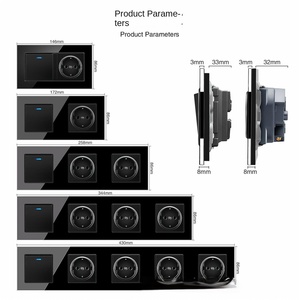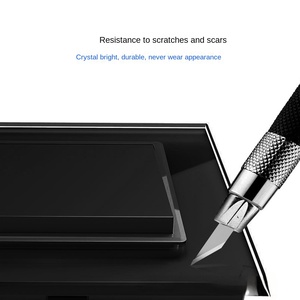
All categories
Featured selections
Trade Assurance
Buyer Central
Help Center
Get the app
Become a supplier

(74 products available)























Four-pole double-throw switches come in different types based on their operational characteristics and application settings. Here's a look at some of the most common varieties.
These switches are operated manually and require physical action – usually by pressing, flipping, or rotating – to change the switch position.
These switches automatically change their state due to external factors, such as a change in electrical parameters like voltage, current, or frequency. Of the several types of automatic switches, the most common are the automatic reset four-pole double-throw switch and the intermittent automatic four-pole double-throw switch.
These are modern switches that use semiconductor devices to control operations. They are more sensitive, require less power to operate, and can be integrated into complex electronic systems.
These switches are designed to operate automatically without manual intervention. They change position based on electrical load conditions, such as load current or power fluctuations. This feature is useful for managing systems where load conditions can vary significantly.
These are used when one needs to reset a system intentionally after an event, usually after a fault or trigger condition. This requirement helps ensure that the systems do not switch back automatically, which can pose a risk in some conditions.
Finally, intermittent four-pole double-throw switches are designed to operate for short periods under certain load conditions before returning to a normal state. This operation allows for temporary processes like testing machinery under load for short periods.
Four-pole double-throw switches are mainly used to help transfer circuits and control loads in industrial settings, especially ones with high electrical demands. Here are some common applications of these switches.
In generators and other power sources, four-pole double-throw switches help switch between different power sources, enabling users to select between grid and backup power.
These switches help change the operating modes of motors, such as switching between different speeds, directions, or braking modes. Their operation lets users control the complex functions of industrial motors simply and efficiently.
In industrial automation and control systems, four-pole double-throw switches act as signal selectors or route power to different components. Their role is crucial in helping maintain precise control over the various automated processes that require consistent dependability.
In heating, ventilation, and air conditioning (HVAC) systems, these switches are used to change the operation mode of compressors, fans, and other key components. In these systems, ft four-pole double-throw switches facilitate the changeover between different operating states, such as cooling, heating, and ventilation.
In electrical testing and safety systems, these switches help select test circuits or control load during safety checks. Four-pole double-throw switches provide a means to isolate live circuits from testers, enhancing user safety and preventing electrical mishaps during testing.
In most industrial devices, four-pole double-throw switches control the various operational modes. These switches are critical, allowing users to transition between different processes, thereby helping run complicated manufacturing systems smoothly while providing control over multiple outputs.
Selecting a suitable four-pole double-throw requires buyers to consider various factors to ensure that the switch is both efficient and durable. Here are some key components to keep in mind.
The first thing to consider is the switch's electrical rating, which has to be compatible with the application's voltage and current requirements. Avoiding overload situations ensures that the switch can operate stably under the required conditions without risk of failure.
Since four-pole double-throw switches are mainly used in industrial settings, they need to be robust enough to handle extreme temperatures, humidity levels, and exposure to dust or corrosive substances. One good way to ensure this robustness is to select switches with adequate enclosures and ingress protection (IP) ratings.
In applications like automation, users will often need fast switching with high-frequency operations. In such cases, using a four-pole double-throw electronic switch will make a huge difference compared to the mechanical one since the former has a much faster switching speed. On the other hand, for low-frequency operations, a manual switch will suffice.
For a four-pole switch to be suitable commercially, it must be compliant with the pertinent electrical and safety standards. These standards include such international regulations as the International Electrotechnical Commission (IEC) and Underwriters Laboratories (UL).
Switches can be panel-mounted, for example, or placed in a more integrated manner into other equipment. Mounting styles and their configurations can affect the overall layout of industrial devices. One must also remember the space constraints, as they may limit certain types of installations.
If the application requires frequent switching, users should go for switches with a built-in mechanical assistance feature. These switches will have increased operability, so they will be more resistive to wear and tear in the long run. This consideration is particularly important in applications where the switch is expected to endure frequent use, as in process control systems.
The long-term reliability and efficiency of four-pole double-throw switches in commercial applications can be kept at an optimal level with proper maintenance. Here are some important maintenance tips for buyers to keep in mind.
Switches should be checked frequently for physical wear, such as cracks, chipping, or signs of mechanical damage. Observing signs of rusting, pitting, or corrosion on the switch or its components is equally important because it will also affect functionality. Heat, sparks, and other electrical-related factors can also cause damage, so always check for signs that indicate the damage is extreme.
To help with this, a qualified technician can use specialized equipment to test the switch's electrical parameters, such as voltage and current-carrying capacity. If these parameters are not within their acceptable limits for a certain application, the switch will need to be repaired or replaced.
Four-pole double-throw switches should be cleaned regularly to remove industrial contaminants such as dust, grease, or grime. The best way to clean these switches is usually with soft brushes or compressed air to remove settled particles from the surfaces and crevices.
Mechanical switches require lubrication to ensure smooth operation and decrease wear on the moving parts. This condition is also important because, without lubrication, one can easily experience increased friction, which will eventually lead to premature failure.
Steam and humidity can easily cause corrosion on the internal and external parts of a four-pole double-throw switch. Therefore, using switches with anti-corrosive coatings or enclosures is vital for protecting the switch from moisture and water. However, if water exposure is unavoidable, it is important that the switch be checked and any signs of corrosion rectified immediately.
Extreme temperatures can degrade switch components and their associated wiring and connections, so monitoring the ambient condition and ensuring that the switches are kept in a cool and hospitable environment as much as possible is essential. By reducing the heat exposure on the switch, one will extend the life of all the switch components.
A1: What sets four-pole double-throw switches apart from other switches is their four poles and two throws. The first characteristic allows them to simultaneously control multiple circuits, while the second one enables the switches to alternate between two different operational modes for each circuit.
A2: Yes, in fact, four-pole double-throw switches are designed to handle the complex requirements of industrial applications. These requirements include power generation, motor control, and machinery operation with high electrical loads. After all, these switches give users great control over multiple circuits while maintaining electrical stability and safety.
A3: The best way to avoid corrosion is to use switches with anti-corrosive materials like stainless steel or plastic in their construction. Applying protective coatings to the switch and regular maintenance, such as cleaning and inspection, will also help in preventing corrosion.
A4: Yes, in fact, there are several types of these switches, like load-based and automatic switches, which help automate circuit changes based on electrical parameters. These switches will then reduce the need for manual intervention in operating processes, thus greatly enhancing efficiency in the automation systems.
A5: In electrical testing and safety systems, these switches will help isolate circuits to protect the user during testing procedures. After all, the isolation increases the safety margin and prevents accidental electrical contact, which can pose a significant risk.